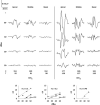Measuring implanted patient response to tone pips
- PMID: 33446195
- PMCID: PMC7807692
- DOI: 10.1186/s12938-020-00844-6
Measuring implanted patient response to tone pips
Abstract
Background: An electrical potential not previously reported-electrical cochlear response (ECR)-observed only in implanted patients is described. Its amplitude and growth slope are a measurement of the stimulation achieved by a tone pip on the auditory nerve. The stimulation and recording system constructed for this purpose, the features of this potential obtained in a group of 43 children, and its possible clinical use are described. The ECR is obtained by averaging the EEG epochs acquired each time the cochlear implant (CI) processes a tone pip of known frequency and intensity when the patient is sleeping and using the CI in everyday mode. The ECR is sensitive to tone pip intensity level, microphone sensitivity, sound processor gain, dynamic range of electrical current, and responsiveness to electrical current of the auditory nerve portion involved with the electrode under test. It allows individual evaluation of intracochlear electrodes by choosing, one at the time, the central frequency of the electrode as the test tone pip frequency, so the ECR measurement due to a variable intensity tone pip allows to establish the suitability of the dynamic range of the electrode current.
Results: There is a difference in ECR measurements when patients are grouped based on their auditory behavior. The ECR slope and amplitude for the Sensitive group is 0.2 μV/dBHL and 10 μV at 50 dBHL compared with 0.04 μV/dBHL and 3 μV at 50dBHL for the Inconsistent group. The clinical cases show that adjusting the dynamic range of current based on the ECR improved the patient's auditory behavior.
Conclusions: ECR can be recorded regardless of the artifact due to the electromyographic activity of the patient and the functioning of the CI. Its amplitude and growth slope versus the intensity of the stimulus differs between electrodes. The relationship between minimum ECR detection intensity level and auditory threshold suggests the possibility of estimating patient auditory thresholds this way. ECR does not depend on the subject's age, cooperation, or health status. It can be obtained at any time after implant surgery and the test procedure is the same regardless of device manufacturer.
Keywords: Cochlear implant fitting; Current dynamic range; Objective test; Pediatric population.
Conflict of interest statement
The authors declare that they have no competing interests.
Figures








References
-
- Guenser G, Laudanski J, Phillipon B, Backus BC, Bordure P, Romanet P, et al. The relationship between electrical auditory brainstem responses and perceptual thresholds in Digisonic® SP cochlear implant users. Cochlear Implants Int. 2015;16(1):32–38. doi: 10.1179/1754762814y.0000000082. - DOI - PubMed
-
- Gordon KA, Papsin BC, Harrison RV. Toward a battery of behavioral and objective measures to achieve optimal cochlear implant stimulation levels in children. Ear Hear. 2004;25(5):447–63. https://www.ncbi.nlm.nih.gov/pubmed/15599192. - PubMed
MeSH terms
LinkOut - more resources
Full Text Sources
Other Literature Sources
Medical
Miscellaneous

